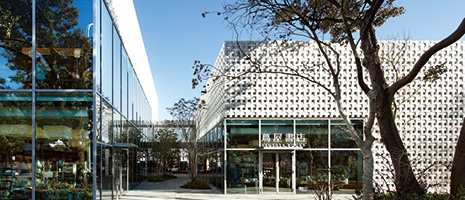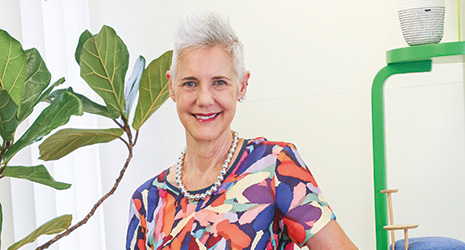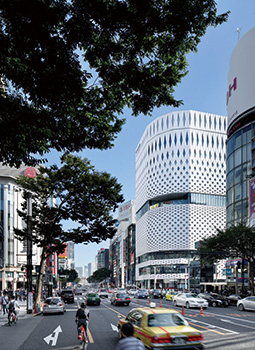Home > Highlighting JAPAN > Highlighting Japan September 2019 > My Way
Highlighting JAPAN


Architecture Breathing New Life into Japan’s Cities
Astrid Klein, an Italian-born architect based in Tokyo, has won international acclaim with her business partners for their experiential and emotive building designs.
The DAIKANYAMA T-SITE shopping complex, which opened in Tokyo’s Shibuya City in 2011, is a beautiful building — playful and light. Its white, lacy exterior walls are made up of countless small interlocking Ts (T being the brand logo of the commissioning bookstore chain), and the building itself is shaped like a T. Inside the bookstore, which is the core of the new shopping complex, customers can enjoy the reading materials while relaxing with a coffee on the benches and sofas arranged around the windows. In 2012, the building design won numerous awards in the World Architecture Festival, including the Best Shopping Centre Award. One of the architects involved in designing the complex is Astrid Klein of Klein Dytham architecture (KDa).
Klein, who was born in Italy, studied architecture and interior design in France and the UK. In 1988, she visited Japan with Mark Dytham, who studied alongside her at college. It was at the height of the economic bubble and creative buildings that “think outside the box” were being built one after another in Japan. Realizing this, the business partners decided to try working in Japan and joined Toyo Ito & Associates, Architects.
Klein says, “Back then, it was the norm for architects to have their own unique style so you could tell whose design is was just by looking at the building. But Ito-san creates designs to suit the situation, bringing people together for unique experiences and so his buildings are different every time. I really, really liked this way of thinking.”
Klein and Dytham established KDa in 1991, since when they have continued to design buildings on the basis that “experience” is the most important aspect of architecture. Take, for example, Leaf Chapel in Kobuchizawa, Yamanashi Prefecture — one of KDa’s representative works. At this dome-shaped chapel, formed by two “leaves” one on top of the other, the upper leaf opens and closes in step with the ceremony, heightening the experience of those “inside.”
Klein’s activities extend beyond architecture to a wide range of fields. One example is PechaKucha Night, a presentation event for creative people devised by Klein and Dytham in 2003. “PechaKucha” “is an onomatopoeic Japanese phrase meaning “chit chat.” The events, in which presenters show 20 slides for 20 seconds each, have become a global movement, with PechaKucha Nights now running in over 1,180 cities around the world.
Klein says that “despite being able to create lots of amazing content admired by people around the world, in terms of both products and fashion, Japanese are not very good at communicating this.” For five years now, Klein has been taking part in the government’s Regional Cool Japan Promotion Council and making recommendations. Klein continues, “Tokyo needs to emphasize its appeal as a city. As far as design is concerned, Tokyo has a huge global presence. But thirty years ago it was a wilder, a more interesting city.”
Cityscape regulations have become stricter and, while Tokyo has become more aesthetically pleasing, by the same score, its architecture has become homogenous and has lost its old vigor.
“Tokyo is the city where I have lived the longest, and it is a city that I love and will continue to work out of in the future,” says Klein. “What Tokyo needs most is a Wow! factor.”
With “experience” and “emotion” as its underlying concepts, Klein’s work will continue to breathe new life into Japan’s cities.
© 2009 Cabinet Office, Government of Japan







